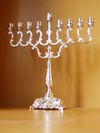Menorah (Temple)

The menorah (Hebrew: מְנוֹרָה) is described in the Bible as the seven-branched candelabrum made of gold and used in the portable sanctuary set up by Moses in the wilderness and later in the Temple in Jerusalem. Fresh olive oil of the purest quality was burned daily to light its lamps. The menorah has been a symbol of Judaism since ancient times and is the emblem on the coat of arms of the modern state of Israel.
Contents |
Construction
The menorah consisted of a base and a shaft with six branches, beaten out of solid gold. The six branches curved to the height of the central shaft so that all seven lamps at their apexes were in a straight line.[1]
The Hebrew Bible, or Torah, states that God revealed the design for the menorah to Moses and describes the construction of the menorah as follows (Exodus 25:31-40):
31 And thou shalt make a candlestick of pure gold: of beaten work shall the candlestick be made, even its base, and its shaft; its cups, its knops, and its flowers, shall be of one piece with it. 32 And there shall be six branches going out of the sides thereof: three branches of the candlestick out of the one side thereof, and three branches of the candle-stick out of the other side thereof; 33 three cups made like almond-blossoms in one branch, a knop and a flower; and three cups made like almond-blossoms in the other branch, a knop and a flower; so for the six branches going out of the candlestick. 34 And in the candlestick four cups made like almond-blossoms, the knops thereof, and the flowers thereof. 35 And a knop under two branches of one piece with it, and a knop under two branches of one piece with it, and a knop under two branches of one piece with it, for the six branches going out of the candlestick. 36 Their knops and their branches shall be of one piece with it; the whole of it one beaten work of pure gold. 37 And thou shalt make the lamps thereof, seven; and they shall light the lamps thereof, to give light over against it. 38 And the tongs thereof, and the snuffdishes thereof, shall be of pure gold. 39 Of a talent of pure gold shall it be made, with all these vessels. 40 And see that thou make them after their pattern, which is being shown thee in the mount.
The branches are often artistically depicted as semicircular, but Rashi[2] and Maimonides,[3] according to his son Avraham,[4] held that they were straight; no other Jewish authority expresses an opinion on the subject.[5]
Archaeological evidence, including depictions by artists who had seen the menorah, indicates that they were neither straight nor semicircular but elliptical.[6] The earliest preserved representation of the menorah of the Temple is depicted in a frieze on the Arch of Titus, commemorating his triumphal parade in Rome following the destruction of Jerusalem in the year 70. Representations of the seven branched candlebrum have been found on tombs and monuments dating from the first century as a frequently used symbol of Judaism and the Jewish people.[1]
It has been noted that the shape of the menorah bears a certain resemblance to that of the plant Salvia palaestina.[7]
Use
The lamps of the menorah were lit daily from fresh, consecrated olive oil and burned from evening until morning, according to Exodus 27:21.
The Roman-Jewish historian Flavius Josephus states that three of the seven lamps were allowed to burn during the day also; however, according to the Talmud (Rashi, Tractate Shabbat 22b), only the center lamp was left burning all day. It was called the ner hama'aravi (Western lamp) because of its position. This lamp was also referred to as the ner Elohim (lamp of God), mentioned in I Samuel 3:3.[1]
History and fate
The original menorah was made for the Tabernacle, and the Bible records it as being present until the Israelites crossed the Jordan river. When the Tabernacle is pitched in Shiloh (Joshua 18:1), it assumed that the menorah was also present. However, no mention is made of it during the years that the Ark of the Covenant was moved in the times of Samuel and Saul. There is no further mention of the menorah in Solomon's temple, as he creates ten candlesticks (2 Chronicles 4:7). These are recorded as being taken away to Babylon by the invading armies under the general Nebuzar-Adan (Jeremiah 52:19) some centuries later.
During the restoration of the Temple worship after the captivity in Babylon, no mention is made of the return of the menorah or of any of Solomon's candlesticks, but only of "vessels" (Ezra 1:9-10). Since the Temple was an enclosed place with no natural light, some means of illumination must have existed.

Although apocryphal, the Book of Maccabees record that Antiochus Epiphanes took away the candlesticks (plural) when he invaded and robbed the Temple (1 Maccabees 1:21). The later record of the making of "new holy vessels" may refer to the manufacture of new candlesticks (1 Maccabees 4:49). There is thereafter no Biblical mention of the fate of the menorah.
The fate of the menorah used in the Second Temple is recorded by Josephus, who states that it was brought to Rome and carried along during the triumph of Vespasian and Titus. The menorah probably remained in the Temple of Peace in Rome until the city was sacked by the Visigoths under Alaric I in 410 CE.
Most likely, the menorah was looted by the Vandals in the sacking of Rome in 455 CE, and taken to their capital, Carthage.[8] The Byzantine army under General Belisarius might have removed it in 533 and brought it to Constantinople. According to Procopius, it was carried through the streets of Constantinople during Belisarius' triumphal procession. Procopius adds that the object was later sent back to Jerusalem where there is no record of it, although it could have been destroyed when Jerusalem was pillaged by the Persians in 614.
Symbolism
The menorah symbolized the ideal of universal enlightenment. The seven branches allude to the branches of human knowledge, represented by the six lamps inclined inwards towards, and symbolically guided by, the light of God represented by the central lamp. The menorah also symbolizes the creation in seven days, with the center light representing the Sabbath.[1] It is also said to symbolize the burning bush as seen by Moses on Mount Horeb (Exodus 3).
Hanukkah
The Menorah is also a symbol closely associated with the Jewish holiday of Hanukkah. According to the Talmud, after the Seleucid desecration of the Jewish Temple in Jerusalem, there was only enough sealed (and therefore not desecrated) consecrated olive oil left to fuel the eternal flame in the Temple for one day. Miraculously, the oil burned for eight days which was enough time to make new pure oil.
The Talmud (Menahot 28b) states that it is prohibited to use a seven-branced menorah outside of the Temple. The Hanukkah menorah therefore has eight main branches, plus a ninth branch set apart as the shamash (servant) light which is used to kindle the other lights. This type of menorah is called a hanukiah in Modern Hebrew.[1]
Modern use
Synagogues have a continually lit lamp or light in front of the Ark, where the Torah scroll is kept, called the ner tamid (eternal light). This lamp represents the continually lit ner Elohim of the menorah used in Temple times.[1]
In addition, many synagogues display either a Menorah or an artistic representation of a menorah.
A menorah appears in the coat of arms of the State of Israel, based on the depiction of the menorah on the Arch of Titus.
In other cultures
The kinara is also, like the menora, a seven-branch candleholder which is associated with the African American festival of Kwanzaa. One candle is lit on each day of the week-long celebration, in a similar manner as the Hanukiah (which was modeled after the menora) during Hanukkah.
Gallery
 Second Temple period stone tablet from a synagogue in Peki'in, Israel |
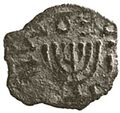 Coin depicting a menorah issued by the last Hasmonean king, Mattathias Antigonus, c. 40BCE |
 Maimonides' drawing of the menorah |
 The Jewish Legion cap badge: menorah and word קדימה Kadima (forward) |
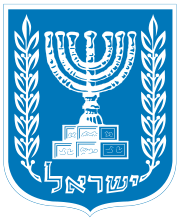 The Coat of Arms of Israel shows a menorah surrounded by an olive branch on each side and the writing "ישראל" (Israel) based on its depiction on the Arch of Titus. |
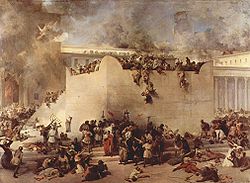 The Menorah is seen being sacked as the Holy Temple in Jerusalem was being destroyed by the Roman army. (70 C.E.) |
Menorah monument at Jewish Cemetery of Theresienstadt concentration camp |
|
 The Knesset Menorah outside the Knesset (Israeli Parliament). |
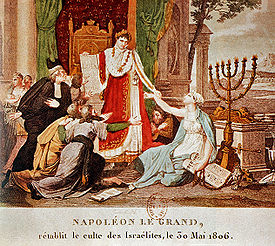 In this 1806 French print, the woman with the Menorah represents the Jews being emancipated by Napoleon Bonaparte |
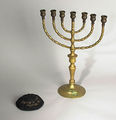 Kippa and Menorah from the Harry S Truman collection |
 The Menorah, presented to Tsar Boris III from the Bulgarian Jewish community (Tsarska Bistritsa) |
References
- ↑ 1.0 1.1 1.2 1.3 1.4 1.5 Birnbaum, Philip (1975). A Book of Jewish Concepts. New York: Hebrew Publishing Company. pp. 366-367. ISBN 88482876X.
- ↑ Exodus 25:32
- ↑ Maimonides depicted them as straight in two separate manuscript drawings. But see Seth Mandel's alternative interpretation below.
- ↑ Commentary on Exodus, ch 7
- ↑ See Likutei Sichot vol 21 pp 168-171
- ↑ Mandel, Seth The shape of the Menorah of the Temple Avodah Mailing List, Vol 12 Num 65
- ↑ JTS Taste of Torah commentary, 18 June 2005
- ↑ Edward Gibbon: The History of the Decline and Fall of the Roman Empire (Volume 7: Chapter XLI. From the Online Library of Liberty. The J. B. Bury edition, in 12 volumes.)
See also
- Menorah (Hanukkah)
- Jewish symbols
- Arch of Titus
- Hanukkah
- Knesset Menorah
- Mishneh Torah Avodah Laws of the Temple 3:1-10
External links
- JewishEncyclopedia.com: Candlestick - By Emil G. Hirsch, Wilhelm Nowack
- JewishEncyclopedia.com: Arch of Titus - By Morris Jastrow Jr., Immanuel Benzinger
- JewishEncyclopedia.com: Menorah - By Cyrus Adler, Judah David Eisenstein
|
||||||||||||||||||||
|
|||||||||||||||||||||||||
|
||||||||||



